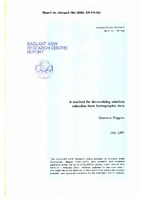| dc.contributor.author | Peggion, Germana | |
| dc.date.accessioned | 2018-10-11T14:06:41Z | |
| dc.date.available | 2018-10-11T14:06:41Z | |
| dc.date.issued | 1987/07 | |
| dc.identifier | 1894 | |
| dc.identifier.govdoc | SR-114 | |
| dc.identifier.uri | http://hdl.handle.net/20.500.12489/283 | |
| dc.description.abstract | This study describes a procedure for deriving the characteristics of large-scale climatic currents from | |
| dc.description.abstract | hydrographic data of a variable depth region of the ocean. The model equations are written on a betaplane, | |
| dc.description.abstract | using the geostrophic, hydrostatic, and Boussinesq approximations. The effects of surface and bottom boundary layers, and turbulent transfers of mass and momentum are neglected. The model is formulated such that the velocities, which are the solutions of the thermal wind equations, are referred to the (unknown) bottom velocities. Within the assigned dynamical constraints, a differential equation for the bottom pressure associated with the bottom geostrophic velocities can be derived. The equation would hold exactly if the model equations exactly described the motion, or if the hydrographic data did not contain errors and noise. The misfit, which is assumed never to be zero, is an additional unknown component of the problem. To handle the indeterminacy of the problem, the | |
| dc.description.abstract | absolute velocities are chosen to minimize the variance of the misfit over the whole region of interest. | |
| dc.description.abstract | The method is illustrated by applications. | |
| dc.format | 28 p. : ill. ; 9 fig. | |
| dc.language | English | |
| dc.publisher | NATO. SACLANTCEN | |
| dc.relation.ispartofseries | ADB117448 | |
| dc.subject | Currents | |
| dc.title | A method for determining absolute velocities from hydrographic data | |
| dc.type | Scientific Report (SR) | |
